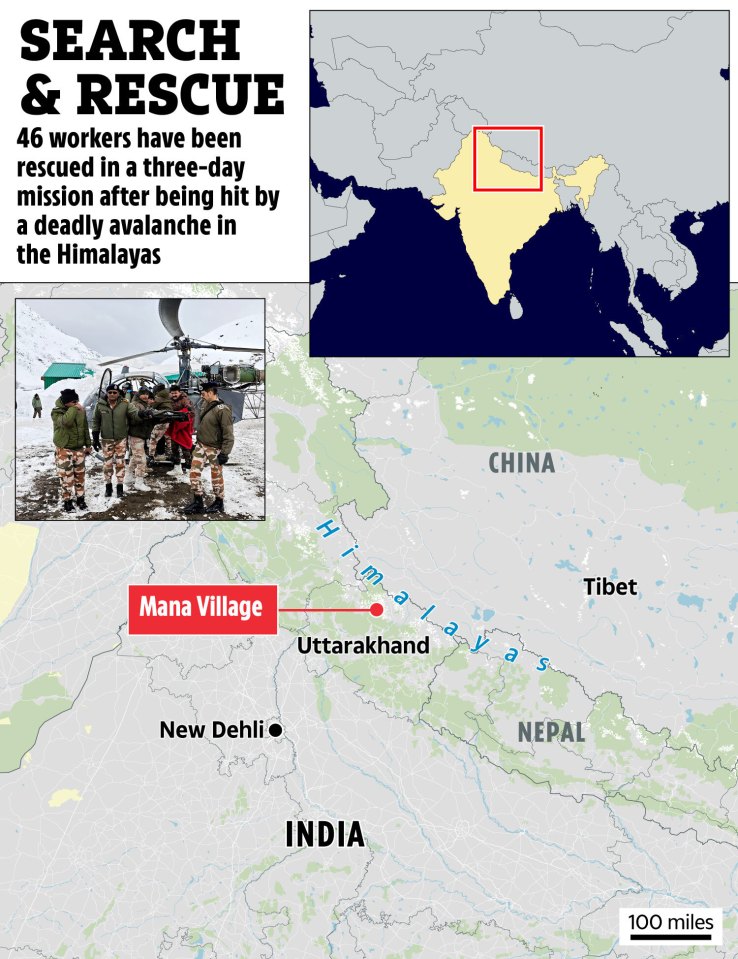A HEROIC rescue mission saw dozens of construction workers pulled out alive from metal containers after being buried by an avalanche.
On Friday, 54 construction workers were submerged under snow and debris after the avalanche hit the work site in the Himalayas, killing eight.
A lengthy search and rescue mission at the camp near Mana Village, in the Indian state of Uttarakhand, lasted three days in subzero temperatures with the last people pulled out on Sunday.
Eight of the metal containers and a shed were thrown down the side of the mountain by the cascade of snow and ice at around 6 am.
Rescuers had a race against time as the trapped workers had a limited supply of oxygen.
Construction worker Anil, recalled his rescue hours after being buried by the avalanche.
read more on news
"It was if God's angels had come to save us," he said from his hospital bed.
"The way we were engulfed in snow, we had no hope of surviving."
Being alive now felt "like a dream", he said.
Anil, who is in his late 20s said that many of his colleagues were asleep or using makeshift toilets when disaster struck and they felt the ground shake and their container slide down the mountain.
Most read in The Sun
"At first we did not understand what was happening but when we looked out of the window of the containers, we saw piles of snow all around," he said.
"The roof of the containers was also slowly bending inwards."
The men started screaming and some were able to escape while others were left trapped inside.
Anil's co-worker Vipan Kumar told the Times of India newspaper how he thought "this was the end" when he found himself trapped under thick snow and struggling to breathe.
"I heard a loud roar, like thunder ... before I could react, everything went dark," he said.
Rescuers told a local news outlet that the labourers only survived thanks to the strength of their make-shift shelters that were able to "withstand the wrecking avalanche."
A senior rescue official told The Times of India: "These metal shelters saved most of them.
"They had just enough oxygen to hold on until we got them out."
Satyaprakash Yadav, one of the workers who was rescued said in a video released by the army that the "avalanche hit our container like a landslide."
The force of the impact broke up the container and it landed perilously close to the edge of an icy river.
"We managed to get our on our own and reached a nearby army guest house, where we stayed overnight," the worker from Uttar Pradesh said.
Fellow worker Rajnish Kumar added: "When the snow hit the container, it sank about 50 to 60 metres down [the mountain].
"The Army arrived quickly and rescued us."
Rescuers from the Indian army, national and state disaster response forces and local administration used helicopters, drones, thermal imaging and sniffer dogs in the gruelling mission.
Uttarakhand state Chief Minister Pushkar Singh Dhami has thanked them for their efforts.
The Indo-Tibetan Border Police shared footage of the rescue on X saying: "After 3 days of relentless efforts, the joint rescue op by #ITBP, Army, NDRF & state Govt. at Mana, Chamoli, successfully concludes.
"46 lives saved are under medical care, 8 bodies recovered, Sniffer dogs & thermal imaging used.
"A testament to unwavering courage & coordination!"
Footage shows rescuers accessing the containers by walking through thigh-high snow and carrying people to safety on stretchers hoisted up onto their shoulders.
The camp which is at an altitude of more than 10,500 feet sees minimum temperatures plummet to -12C.
The workers were part of a highway expansion project by the Border Roads Organisation.
Avalanches and landslides are common in the upper reaches of the Himalayas, especially during the winter season.
Read More on The Sun
In 2021, nearly 100 people died in Uttarakhand after a huge glacier chunk fell into a river, triggering flash floods.
And devastating monsoon floods and landslides in 2013 killed 6,000 people and led to calls for a review of development projects in the state.















